[English] 日本語
 Yorodumi
Yorodumi- PDB-6uwz: Cryo-EM structure of Torpedo acetylcholine receptor in complex wi... -
+ Open data
Open data
- Basic information
Basic information
| Entry | Database: PDB / ID: 6uwz | |||||||||||||||||||||||||||||||||||||||||||||||||||||||||||||||||||||
|---|---|---|---|---|---|---|---|---|---|---|---|---|---|---|---|---|---|---|---|---|---|---|---|---|---|---|---|---|---|---|---|---|---|---|---|---|---|---|---|---|---|---|---|---|---|---|---|---|---|---|---|---|---|---|---|---|---|---|---|---|---|---|---|---|---|---|---|---|---|---|
| Title | Cryo-EM structure of Torpedo acetylcholine receptor in complex with alpha-bungarotoxin | |||||||||||||||||||||||||||||||||||||||||||||||||||||||||||||||||||||
 Components Components |
| |||||||||||||||||||||||||||||||||||||||||||||||||||||||||||||||||||||
 Keywords Keywords | TRANSPORT PROTEIN / Nicotinic acetylcholine receptor / nicotinic receptor / Torpedo / Cys-loop receptor / ion channel / neurotoxin | |||||||||||||||||||||||||||||||||||||||||||||||||||||||||||||||||||||
| Function / homology |  Function and homology information Function and homology informationacetylcholine receptor inhibitor activity / acetylcholine-gated monoatomic cation-selective channel activity / ion channel regulator activity / transmitter-gated monoatomic ion channel activity involved in regulation of postsynaptic membrane potential / transmembrane signaling receptor activity / toxin activity / postsynaptic membrane / extracellular region Similarity search - Function | |||||||||||||||||||||||||||||||||||||||||||||||||||||||||||||||||||||
| Biological species |   Bungarus multicinctus (many-banded krait) Bungarus multicinctus (many-banded krait) | |||||||||||||||||||||||||||||||||||||||||||||||||||||||||||||||||||||
| Method | ELECTRON MICROSCOPY / single particle reconstruction / cryo EM / Resolution: 2.69 Å | |||||||||||||||||||||||||||||||||||||||||||||||||||||||||||||||||||||
 Authors Authors | Rahman, M.M. / Teng, J. / Worrell, B.T. / Noveillo, C.M. / Lee, M. / Karlin, A. / Stowell, M. / Hibbs, R.E. | |||||||||||||||||||||||||||||||||||||||||||||||||||||||||||||||||||||
| Funding support |  United States, 1items United States, 1items
| |||||||||||||||||||||||||||||||||||||||||||||||||||||||||||||||||||||
 Citation Citation |  Journal: Neuron / Year: 2020 Journal: Neuron / Year: 2020Title: Structure of the Native Muscle-type Nicotinic Receptor and Inhibition by Snake Venom Toxins. Authors: Md Mahfuzur Rahman / Jinfeng Teng / Brady T Worrell / Colleen M Noviello / Myeongseon Lee / Arthur Karlin / Michael H B Stowell / Ryan E Hibbs /  Abstract: The nicotinic acetylcholine receptor, a pentameric ligand-gated ion channel, converts the free energy of binding of the neurotransmitter acetylcholine into opening of its central pore. Here we ...The nicotinic acetylcholine receptor, a pentameric ligand-gated ion channel, converts the free energy of binding of the neurotransmitter acetylcholine into opening of its central pore. Here we present the first high-resolution structure of the receptor type found in muscle-endplate membrane and in the muscle-derived electric tissues of fish. The native receptor was purified from Torpedo electric tissue and functionally reconstituted in lipids optimal for cryo-electron microscopy. The receptor was stabilized in a closed state by the binding of α-bungarotoxin. The structure reveals the binding of a toxin molecule at each of two subunit interfaces in a manner that would block the binding of acetylcholine. It also reveals a closed gate in the ion-conducting pore, formed by hydrophobic amino acid side chains, located ∼60 Å from the toxin binding sites. The structure provides a framework for understanding gating in ligand-gated channels and how mutations in the acetylcholine receptor cause congenital myasthenic syndromes. | |||||||||||||||||||||||||||||||||||||||||||||||||||||||||||||||||||||
| History |
|
- Structure visualization
Structure visualization
| Movie |
 Movie viewer Movie viewer |
|---|---|
| Structure viewer | Molecule:  Molmil Molmil Jmol/JSmol Jmol/JSmol |
- Downloads & links
Downloads & links
- Download
Download
| PDBx/mmCIF format |  6uwz.cif.gz 6uwz.cif.gz | 427.5 KB | Display |  PDBx/mmCIF format PDBx/mmCIF format |
|---|---|---|---|---|
| PDB format |  pdb6uwz.ent.gz pdb6uwz.ent.gz | 336.3 KB | Display |  PDB format PDB format |
| PDBx/mmJSON format |  6uwz.json.gz 6uwz.json.gz | Tree view |  PDBx/mmJSON format PDBx/mmJSON format | |
| Others |  Other downloads Other downloads |
-Validation report
| Summary document |  6uwz_validation.pdf.gz 6uwz_validation.pdf.gz | 1.8 MB | Display |  wwPDB validaton report wwPDB validaton report |
|---|---|---|---|---|
| Full document |  6uwz_full_validation.pdf.gz 6uwz_full_validation.pdf.gz | 1.9 MB | Display | |
| Data in XML |  6uwz_validation.xml.gz 6uwz_validation.xml.gz | 72.3 KB | Display | |
| Data in CIF |  6uwz_validation.cif.gz 6uwz_validation.cif.gz | 108.1 KB | Display | |
| Arichive directory |  https://data.pdbj.org/pub/pdb/validation_reports/uw/6uwz https://data.pdbj.org/pub/pdb/validation_reports/uw/6uwz ftp://data.pdbj.org/pub/pdb/validation_reports/uw/6uwz ftp://data.pdbj.org/pub/pdb/validation_reports/uw/6uwz | HTTPS FTP |
-Related structure data
| Related structure data |  20928MC M: map data used to model this data C: citing same article ( |
|---|---|
| Similar structure data |
- Links
Links
- Assembly
Assembly
| Deposited unit | 
|
|---|---|
| 1 |
|
- Components
Components
-Acetylcholine receptor subunit ... , 4 types, 5 molecules ADBCE
| #1: Protein | Mass: 50168.164 Da / Num. of mol.: 2 / Source method: isolated from a natural source Source: (natural)  References: UniProt: P02710 #2: Protein | | Mass: 57625.711 Da / Num. of mol.: 1 / Source method: isolated from a natural source Source: (natural)  References: UniProt: P02718 #3: Protein | | Mass: 53731.773 Da / Num. of mol.: 1 / Source method: isolated from a natural source Source: (natural)  References: UniProt: P02712 #4: Protein | | Mass: 56574.094 Da / Num. of mol.: 1 / Source method: isolated from a natural source Source: (natural)  References: UniProt: P02714 |
|---|
-Protein , 1 types, 2 molecules FG
| #5: Protein | Mass: 8005.281 Da / Num. of mol.: 2 / Source method: obtained synthetically / Source: (synth.)  Bungarus multicinctus (many-banded krait) / References: UniProt: P60615 Bungarus multicinctus (many-banded krait) / References: UniProt: P60615 |
|---|
-Sugars , 4 types, 8 molecules 
| #6: Polysaccharide | Source method: isolated from a genetically manipulated source #7: Polysaccharide | Source method: isolated from a genetically manipulated source #8: Polysaccharide | alpha-D-mannopyranose-(1-6)-alpha-D-mannopyranose-(1-6)-2-acetamido-2-deoxy-beta-D-glucopyranose-(1- ...alpha-D-mannopyranose-(1-6)-alpha-D-mannopyranose-(1-6)-2-acetamido-2-deoxy-beta-D-glucopyranose-(1-4)-2-acetamido-2-deoxy-beta-D-glucopyranose-(1-4)-2-acetamido-2-deoxy-beta-D-glucopyranose | Source method: isolated from a genetically manipulated source #10: Sugar | |
|---|
-Non-polymers , 3 types, 144 molecules 
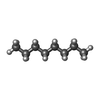



| #9: Chemical | ChemComp-POV / ( #11: Chemical | ChemComp-OCT / | #12: Water | ChemComp-HOH / | |
|---|
-Details
| Has ligand of interest | N |
|---|---|
| Has protein modification | Y |
-Experimental details
-Experiment
| Experiment | Method: ELECTRON MICROSCOPY |
|---|---|
| EM experiment | Aggregation state: PARTICLE / 3D reconstruction method: single particle reconstruction |
- Sample preparation
Sample preparation
| Component | Name: Torpedo acetylcholine receptor in complex with alpha-bungarotoxin Type: COMPLEX / Entity ID: #1-#5 / Source: NATURAL |
|---|---|
| Molecular weight | Units: KILODALTONS/NANOMETER / Experimental value: NO |
| Source (natural) | Organism:  |
| Buffer solution | pH: 7.4 |
| Specimen | Embedding applied: NO / Shadowing applied: NO / Staining applied: NO / Vitrification applied: YES |
| Vitrification | Cryogen name: ETHANE |
- Electron microscopy imaging
Electron microscopy imaging
| Experimental equipment |  Model: Titan Krios / Image courtesy: FEI Company |
|---|---|
| Microscopy | Model: FEI TITAN KRIOS |
| Electron gun | Electron source:  FIELD EMISSION GUN / Accelerating voltage: 300 kV / Illumination mode: FLOOD BEAM FIELD EMISSION GUN / Accelerating voltage: 300 kV / Illumination mode: FLOOD BEAM |
| Electron lens | Mode: BRIGHT FIELD |
| Image recording | Electron dose: 35 e/Å2 / Film or detector model: GATAN K3 (6k x 4k) |
- Processing
Processing
| EM software |
| ||||||||||||
|---|---|---|---|---|---|---|---|---|---|---|---|---|---|
| CTF correction | Type: PHASE FLIPPING AND AMPLITUDE CORRECTION | ||||||||||||
| Symmetry | Point symmetry: C1 (asymmetric) | ||||||||||||
| 3D reconstruction | Resolution: 2.69 Å / Resolution method: FSC 0.143 CUT-OFF / Num. of particles: 127482 / Algorithm: BACK PROJECTION / Symmetry type: POINT |
 Movie
Movie Controller
Controller



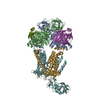

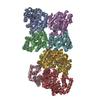
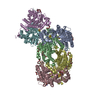
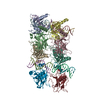

 PDBj
PDBj






